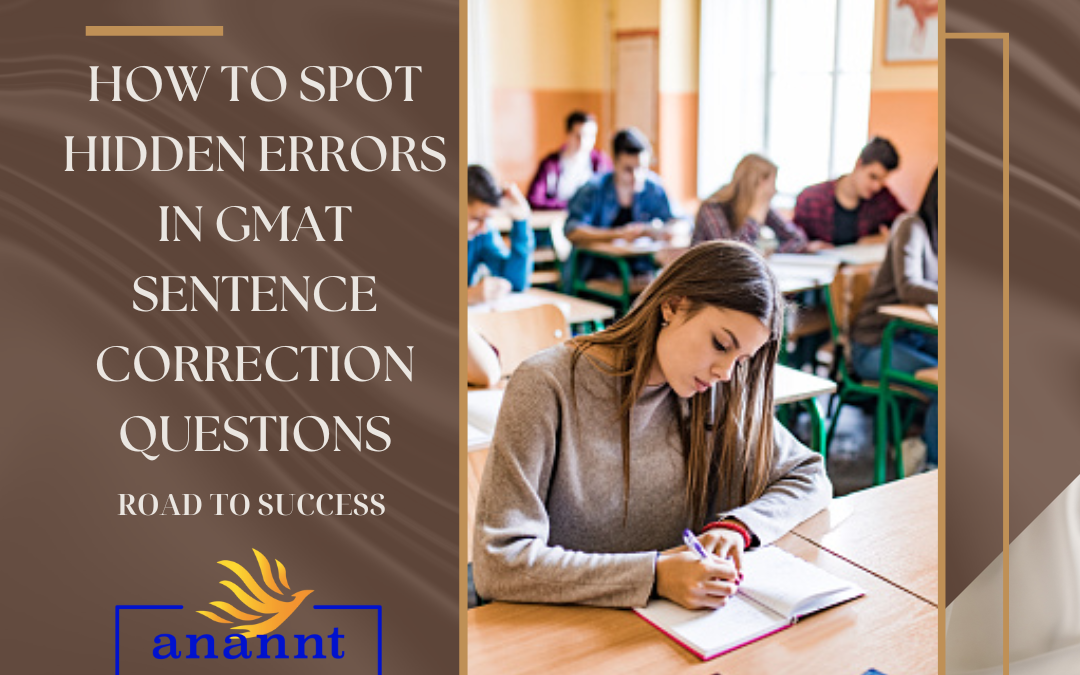
by Nabeela | Dec 23, 2022 | GMAT, Test, Tips
When it comes to preparing for the GMAT exam, one of the most important
and challenging sections is sentence correction. As part of this section, you’ll
be required to identify any hidden errors in a given sentence and choose the
best answer from a list of provided options. While this may seem daunting at
first, there are some useful strategies you can use to make sure you’re able to
spot any potential errors quickly and accurately.
Given below are tips on how to spot hidden errors in GMAT sentence correction questions
Identifying the Grammar Rule at Play
- The first step when dealing with GMAT sentence corrections is understanding
the grammar rule that applies to each question. In order to do this effectively,
you need to read through the sentence carefully and identify any words that
are unusual or confusing.
- Additionally, look out for linking verbs and pronouns
as they can often indicate where errors may be found. Taking some time to
familiarize yourself with different grammar rules beforehand can also be
beneficial; by doing so you will have better contextual understanding on how
various elements interact within sentences.
- This can help narrow down your choices when presented with an array of possible answers.
Checking for Parallelism
- Incorrect parallelism is a common mistake seen in many GMAT sentence
correction questions; it’s important that you take note of any phrases
containing similar verb forms or nouns such as adjective phrases or verb
phrases, ensuring they maintain their structure throughout each part of the
sentence.
- To illustrate this point better an example could be “behaves badly”
appearing in one part of a sentence but “acts badly” appearing elsewhere; in
this case it would not be considered parallel as there is a difference in terms
of verb forms used between both parts of the phrase. So if you notice
something like this occurring then chances are it needs correcting!
Investigating Word Usage & Punctuation
- Aside from grammar rules there are other aspects that need checking such as
word usage and punctuation marks. Make sure all spelling mistakes have
been corrected as incorrect spellings can lead to misinterpretations easily
being made by readers! Also take into account proper nouns used within
sentences – do they match up correctly with other parts of speech? Are they
capitalized correctly? If not then unfortunately this may suggest an error has
occurred somewhere along the line which needs rectifying before continuing
further with your answer choice selection process.
- Additionally check for misplaced commas, apostrophes and hyphens as these too can throw off an
entire phrase or clause if absent from where they should properly be located
within it!
Analyzing Modifiers
- When solving GMAT sentence corrections, modifiers play an important role
too; if these become misplaced within sentences then chances are a
grammatical or syntactical error has been made somewhere along the line
which requires addressing before continuing further with your answer choice
selection process.
- Furthermore check that any adverbs used still make sense
after being switched around with alternative parts of speech within a given
phrase or clause – this could help reveal potential errors which may have
otherwise gone unnoticed due to poor placement or setup originally occurring
within them!
Exploring Beyond Grammar & Syntax Rules
- No matter how well-versed you are in English grammar and syntax rules,
sometimes it’s necessary to go beyond these boundaries when tackling GMAT
sentences corrections – particularly if you’re struggling with learning all of
them upfront! Instead try looking at how certain parts of speech interact with
each other — such as articles or prepositions — and see if anything appears
out-of-place here too; often understanding how language works on deeper
levels can uncover underlying issues even if conventional grammar rules
aren’t broken!
By following these five steps closely when dealing with GMAT Sentence
Corrections questions, you will be able to more easily identify hidden errors
which may otherwise have gone unnoticed — giving you a greater chance at
success during your exam! Even if two phrase structures look identical at first
glance there could still be subtle differences occurring between them which
require narrowing down before reaching your final answer choice decision —
so make sure not forget about details like parallelism, word usage &
punctuation marks (including homonyms), modifiers (particularly adverbs) as
well as exploring beyond traditional grammar/syntax boundaries when needed
against every single question presented during your exam session!
If you need help along the way, our team of experts are here to assist you. Register for GMAT today at the official website. Kindly contact us for any further queries.
Check out our website on the link given below https://anannt.com/

by Jahnvi | Dec 23, 2022 | GMAT
Are you aiming to get a great score on the GMAT Verbal section? If so, then you’re in luck! Here we’ll discuss some useful tips and strategies to maximize your GMAT verbal score and acing this important exam.
Understanding What You’re Being Tested On
The first step toward success on the GMAT Verbal is understanding what types of questions they can ask. The Verbal section includes three categories: reading comprehension, sentence correction, and critical reasoning. The tests include Logic, language usage, grammar knowledge, and problem-solving skills.
Familiarize Yourself with Different Question Types
Take practice tests or study sample questions from books or online resources such as the official GMAT website. After learning what questions will appear on the test. Make sure you understand each question type. How they work and how to identify which kind they will ask to answer. Developing a deeper understanding of each question type will help you be better prepared for any surprises that may arise.
Using Process of Elimination Techniques
The GMAT rewards accuracy more than speed. Take your time when answering questions and think through each one before selecting an answer. One helpful technique is a process of elimination approach. Eliminate the wrong answers, then narrow down your choices until you arrive at the best option. By doing this, you reduce the chances of making careless mistakes and ensures that you won’t be rushed into choosing an answer without fully understanding it first.
Developing Your Vocabulary and Grammar Skills
Having a strong vocabulary as well as a good mastery of English grammar is essential for success in the GMAT Verbal section. Make sure you become familiar with SAT-level words. These often appear in questions testing basic language skills. Additionally, review basic grammar rules such as subject-verb agreement, modifier placement, pronoun usage, etc. As these topics frequently appear in verbal questions too. The more practice you get with these types of questions, the more successful you will be when facing this challenge during the real exam.
Taking Practice Tests & Reviewing Mistakes
Finally, taking practice tests under timed conditions can help get used to the format of the exam. This will also give a sense of how much time should be allocated for each question. After completing practice exams or mock tests, review mistakes to understand why incorrect answers were chosen. So that similar errors won’t resurface during actual testing time.
With dedication and hard work geared towards mastering each aspect mentioned above. Recognizing question types to develop language proficiency. Anyone can maximize their GMAT Verbal score! So put in some effort now and reap the rewards later when it comes time for admissions decisions from top business schools around the world!

by Vishal | Dec 23, 2022 | GMAT, study abroad, Test, Tips
Multiple-choice questions are a common type of assessment used by universities and other organizations. They can be difficult to answer because they often contain irrelevant information and tempting answers that seem correct but aren’t actually relevant. As such, it’s important to have a strategy in place for tackling these kinds of questions and getting them right. This article will discuss some ways in utilizing the GMAT critical reasoning process, improve your GMAT score, and provide tips on how to make sure you get the best possible result.
Using Process Of Elimination To Narrow Down Choices
Process of elimination is a reliable way to choose from multiple choice questions. It eliminates choices that don’t fit all the criteria in the question, which makes it easier to find out which option best matches what’s required. Additionally, going through this process again can help make sure your answer is correct before submitting it.
Making Logical Connections To Increase Accuracy
Making connections between different concepts in a question or passage can help you maximize accuracy on multiple-choice tests. This may involve spotting patterns among arguments presented, bringing external knowledge into play, and formulating possible solutions without relying solely on information provided directly in the text. This type of holistic approach increases your chances of finding the right answer significantly, since more factors are taken into account than just what is explicitly stated in the text.
Practicing for Perfection: A Must For Successful Completion
Finally, practice makes perfect! Studying and Utilizing the GMAT critical reasoning frequently can help improve your ability to solve difficult questions on GMATs or other similar exams, as well as boosting confidence levels and skills necessary for tackling even the most complicated of questions. Taking mock tests regularly will also help you develop a better understanding of how these types of questions work so that you are more likely to be successful when taking them in real life. All this together makes it easier for you to complete entire sections much faster than if you were… Good luck!
For further information:
https://www.mba.com/exams/gmat-exam
by Labhesh | Nov 17, 2020 | GMAT, Motivation, study abroad, Test

GMAT Strategies
During the seriousness about business college, take the GMAT test. Schools realize that on the off chance that you take the GMAT test, you are serious about acquiring a graduate business degree. They likewise know it’s a demonstrated indicator of your capacity to prevail in your picked program. Thus, to score well it’s important to know GMAT Strategies.
Take the one business college test that lifts you from the remainder of the pack since it:
- Demonstrates your responsibility, inspiration, and capacity to prevail in business college.
- Measures your basic reasoning and thinking aptitudes, the two most pertinent abilities to the world’s top alumni business programs.
- Connects you with the best-fit program through customized program suggestions.
- Increases your winning potential and open a universe of chances.
- Business schools trust the GMAT test to advise affirmation choices.
Attempting to plan for the GMAT, yet don’t have a great deal of time left before the test? Regardless of whether you’re in the last phase of a long GMAT prep plan or planning to pack all your concentrating into only half a month, here are some last-minute GMAT Strategies to assist you with acing the test.
4 GMAT Cram Strategies:
In case you’re preparing for the GMAT at the last hour, you’ll have to do so successfully, making the most effective utilization of your time. We should go over the four best last minute GMAT prep tips to benefit as much as possible from your GMAT cram sessions.
#1: Take a Practice Test

practice before the main day
The best method to get ready for the GMAT is to take practice tests with questions composed by the Graduate Management Admissions Council (GMAC) in automated versatile organization (which utilizes a calculation progressively to change in accordance with your ability level as you travel through the test). The appropriate response clarifications will assist you with deciding your weak areas as far as ranges of abilities, question types, and segments you’ll have to concentrate on in your prep.
#2: Review the Format

review the format
Acquainting yourself with the organization of the GMAT is as significant as planning for the content of the questions themselves. You might be a math star, however the GMAT tests quant aptitudes in different ways. You’ll likewise need to become accustomed to the musicality, pacing, and visuals of the test so nothing is an amazement on test day. You can do this, obviously, by taking practice tests, however you ought to likewise survey resources like the Official Guide for GMAT Review 2017 to help yourself to remember the number of questions in each segment and what question types you’ll see on each area of the GMAT.
#3: Review Math and Grammar Rules

also go through math and grammar rules
While the GMAT isn’t a simple test, essential math and syntax aptitudes are critical to your prosperity on the test. Utilize the diagram of fundamental math ideas in the official GMATPrep Software to audit critical abilities and ideas for the quant area.
#4: Go Over Past Practice Problems

review past practice problems
On the off chance that you’ve done arrangements of training issues or finished practice tests, investigate the appropriate response clarifications for the ones you did mistakenly or address types that you will in general battle with. Attempt to see where your reasoning is self-destructing or where you’re committing imprudent errors so you can focus on those shaky areas and abstain from making comparable mistakes on the actual GMAT.
5 GMAT Test-Taking Strategies
#1: Don’t Be Afraid to Guess

don’t leave, but guess
It’s essential to move rapidly through the test and not get hung up on any one question. It may be disappointing to need to figure, yet the GMAT is structured with the goal that you aren’t relied upon to get each and every question right. The manner in which the scores are scaled implies that you can at present get a high score and a high percentile positioning without addressing each question accurately.
In case you don’t know how to address a question, first try to eliminate at least one answer choices. In any case, regardless of whether you can’t, don’t stop for a second to speculate. You’ll chance more regarding time and intellectual competence by fixating on a single question than by speculating.
#2: Choose the Shortest Sentence Correction Answer Choice

Shortest Sentence Correction Answer Choice
In case you’re stuck on a sentence remedy question and need to figure, pick the briefest one. If all else fails, it’s ideal to go with the briefest answer decision. The GMAT by and large favours compact choices over longer ones, so it’s a decent wager (however obviously not 100%).
#3: Work Backwards on Math Problems

working backwards make it easy
For GMAT critical thinking inquiries on the quant area in which you’re asked to solve for an unknown variable, you can regularly work in reverse to spare time. You may have known about this procedure as “plug and chug.” Use one of the offered response decisions to plug into the equation; in the event that you pick one in the given numerical range, you can utilize the procedure of elimination of at least one of different answers too. For instance, if answer choice C is 35 and its excessively low, you can eliminate answer choices A and B in the event that they’re, state, 17 and 21.
#4: Use the Provided Scratch Pad

use the scratch pad to note down your thoughts and other related things
At the test, you’ll be given a double-sided laminated scratch pad to compose on with a marker. Here and there, students attempt to recollect significant details from perusing appreciation entries or figures in math issues in their minds. While this may appear as though it’s sparing you time, it really saps your time and vitality.
Keep in mind, you’ll be focused and under time tension, which may make you progressively inclined to overlook little details. For instance, in three-part reading comprehension passages, you’ll need to flip through different pages with various types of data, which can take up a ton of valuable time in the event that you don’t take notes during your initial read. Utilize the scratch pad varying to move easily through each question.
#5: Outline Your Essay
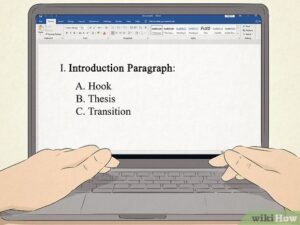
prepare an outline
It might appear as though you should begin composing your 30-minute Analytical Writing Assessment paper immediately, however sketching out already really spares you time and will deliver better outcomes. It will assist you with arranging your thoughts and to communicate them all the more relevantly and successfully, and you can allude back to it as you compose, so you won’t overlook any initial thoughts you had while reading. Utilizing the content manager on the screen or your scratch pad, make a blueprint that tends to the principle contention in the given entry and the significant blemishes in its thinking that you intend to examine. In the event that you utilize the content tool to make your blueprint, simply make a point to eradicate it before you “turn in” your essay.
Day before the GMAT:
- Don’t overstrain yourself on the day preceding your test.
- What hasn’t soaked in at this point won’t mystically hold up itself in your cerebrum short-term.
- Do complete the process of studying early. Take the night off to accomplish something fun and unwinding.
- Do get a decent night’s rest.
Test Day:
- Do get up right on time, have breakfast and show up at the test community 30 minutes before your planned test time.
- Do make sure to bring your visa as a picture ID and water and a vitality bar or other light reward to eat during the breaks.
- Do play out a warm-up directly before the test. Unravel a couple of simple inquiries to get into “math mode.”
- Do remain hopeful. In the event that the questions appear to be excessively troublesome, that may really be a decent sign as your score is subject to the trouble level you figure out how to get from the calculation. Remain quiet, work rapidly however efficiently without hurrying or bouncing into ends.
- Don’t let any single question remove you from your pace or core interest.
- Remember the GMAT Strategies! 🙂
- Also, go through the GMAT Format once.
Look for the nearest test centre and book your GMAT Exam Dates.
by Labhesh | Nov 13, 2020 | Admissions counselling, GMAT, Motivation, study abroad, Test
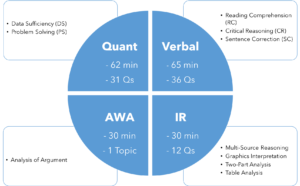
GMAT Exam Format
The GMAT Exam tests you on the following four sections:
- Analytical Writing Analysis
- Integrated Reasoning
- Quantitative
- Verbal
Here’s a concise GMAT Exam Format of every one of these segments:
- AWA – “The Analytical Writing Assessment (AWA) measures your capacity to think fundamentally and to impart your thoughts. During the AWA, you are approached to break down the thinking behind a given argument and compose a study of that argument”.

Analytical Writing Analysis
- Duration: 30 minutes
- Analysis of Argument for 1 Topic
- IR – “The Integrated Reasoning area of the GMAT estimates your capacity to assess data introduced in different arrangements from numerous sources – abilities you have to prevail in our innovatively propelled, information driven world.”

Integrated Reasoning
- Duration: 30 minutes
- 12 Questions of the accompanying question types:
Multi-Source Reasoning
Graphics Interpretation
Two-Part Analysis
Table Analysis
- Quant – “The Quantitative segment quantifies your capacity to break down information and make inferences utilizing thinking abilities. The arithmetic expected to comprehend and solve the questions in this segment of the GMAT test is no more prominent than what is for the most part instructed in secondary school classes.”
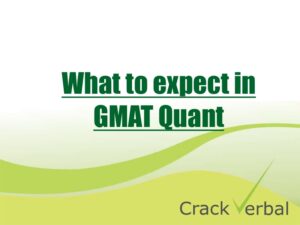
Quantitative Reasoning
- Duration: 62 minutes
- 31 Questions of the accompanying question types:
Problem Solving (PS)
Data Sufficiency (DS)
- Verbal – “The Verbal segment gauges your capacity to read and comprehend written material, to assess contentions, and to address composed material to adjust to standard composed English.”

Verbal GMAT
- Duration: 65 minutes
- 36 Questions from the accompanying themes:
Reading Comprehension (RC)
Critical Reasoning (CR)
Sentence Correction (SC)
Do refer to our GMAT exam syllabus article!!
Also know the GMAT Score calculation before you step into the examination hall. Good luck champs!!
by Labhesh | Nov 11, 2020 | Admissions counselling, GMAT, Motivation, study abroad, Test

GMAT Exam Syllabus
Before reading the GMAT Exam Syllabus, know what is GMAT and the reason behind taking the GMAT Exam.
GMAT Analytical Writing Assessment Exam Syllabus

GMAT Analytical Writing Assessment Syllabus
The Analytical Writing segment will have subjects on which the applicant should write, or passage might be given on which questions will be posed. Based on the passage, the applicant should answer. The schedule for this segment is tremendous and differed as the subject of the section could be any subject of intrigue. The principle thought is to concentrate on the structure of the appropriate response and not the arguments introduced. Keep in mind, it’s anything but a trial of your sentiment yet your writing style, so it is more secure to adhere to unbiased assessment according to the GMAT Exam Syllabus.
In this area, you need to examine the thinking and afterward present your argument. Keep in mind, you will be decided on how all around contemplated you locate a given argument.
In this area, you need to write an essay on the issue given to you. The applicant needs to offer an input in around 600 words. The opinion can be supportive of the given articulation or applicants can offer their own input. Be that as it may, make a point to offer your input in an appropriately organized way as you will be decided on this premise.
GMAT Integrated Reasoning Syllabus
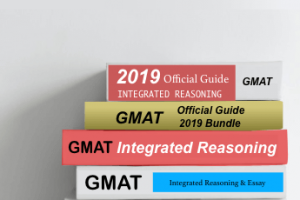
GMAT Integrated Reasoning Syllabus
The Integrated Reasoning area is the freshest expansion in the GMAT Exam Syllabus. This area tests the competitors’ capacity to assess the information introduced in chart or table organization. This segment has 12 questions of the following kind:
This area gauges applicants’ capacity to sort and analyse a table including information, similar to a spreadsheet, to decide the significant data or the one that meets certain conditions.
Measures the competitors’ abilities to take care of complex issues. The issues can be verbal, quantitative, or a blend of both. The configuration is flexible and covers a wide scope of substance. The candidate’s ability to tackle simultaneous equations, assess compromises, and observe connections between two substances is estimated.
It gauges competitors’ abilities to inspect information from various sources tables, illustrations, text sections, or a mix of all the three and analyse each source of information cautiously for addressing numerous questions. The candidates will be approached to draw deductions and others may expect you to decide if information is significant. In a couple of questions, applicants should perceive inconsistencies among various sources of information.
It quantifies candidate’s capacity to interpret the data introduced in a diagram or graphical picture (scatter plot, x/y chart, bar outline, pie graph, or statistical curve distribution) to discover connections, and make deductions.
GMAT Quantitative Reasoning

GMAT Quantitative Reasoning
The Quantitative Section includes two areas, in particular Data Sufficiency and Problem Solving. In the Data Sufficiency area, there will be 18 questions and, in the Problem-Solving segment, there will be 18 questions. The questions will be target type and will have various decision answers. In this area the questions can be normal from the accompanying math syllabus:
It gauges the applicants’ abilities to utilize rationale and systematic thinking for taking care of quantitative issues.
It quantifies the candidate’s capacity to inspect a quantitative issue, distinguish which information is significant, and decide when there is sufficient information to take care of the issue.
The themes are additionally partitioned into the accompanying classifications:
- Geometry
- Elementary Algebra
- Arithmetic
- Ratio Proportions
- Properties of Integers
- Permutation and combinations
- Exponents and roots
- Linear equations etc.
GMAT Verbal Reasoning Syllabus

GMAT Verbal Reasoning Syllabus
This Verbal Skills area will have 36 multiple choice questions. This area is partitioned into Critical Reasoning, Reading Comprehension and Sentence Correction. This segment tests the applicants’ capacity to appreciate the composed material, read and understand the consistent connection between the focuses referenced in the passage and concepts.
It gauges the applicants’ expertise to make arguments, to assess arguments, and detail or assess a strategy.
It gauges the candidate’s aptitude to draw deductions, comprehend legitimate connections between noteworthy points, get words and proclamations, and follow the improvement of quantitative ideas. Aside from this, the applicants’ will be tried on the accompanying understanding abilities: derivation, application, fundamental thought, supporting the thought, intelligent structure, and style.
This area estimates two wide parts of the competitors’ language capability. The main angle is to address articulation while alluding to sentences that are syntactically and fundamentally stable. The subsequent perspective is a successful articulation while alluding to sentences that adequately express a thought or relationship obviously, compactly, and linguistically.
Following areas will be covered in this Verbal Reasoning area:
- Critical thinking
- Rhetorical development of the sentences
- Sentence adjustment identified with discovering blunder or exclusion
- Reading unseen passages
- Subject-action word understanding
- Misplace modifiers
- Countable Vs Uncountable
- Parallelism
Register yourself with Anannt and ace the exam.
























Recent Comments